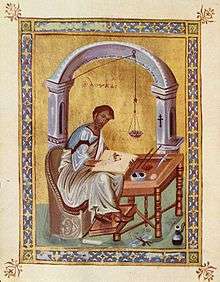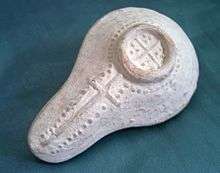Early Christian lamps

In Early Christianity lamps, fire and light are conceived as symbols, if not as visible manifestations, of the divine nature and the divine presence.
In the Christian world view Christ is the true Light,[1] and at his transfiguration the fashion Christian of his countenance was altered, and his raiment was white and glistering;[2] when the Holy Ghost descended upon the apostles, there appeared unto them cloven tongues of fire, and it sat upon each of them;[3] at the conversion of St Paul there shined round him a great light from heaven;[4] while the glorified Christ is represented as standing in the midst of seven candlesticks ... his head and hairs white like wool, as white as snow; and his eyes as a flame of fire.[5] Christians are children of Light at perpetual war with the powers of darkness.
There is no evidence of any ceremonial use of lights in Christian worship during its first two centuries. It is recorded, indeed,[6] that on the occasion of St. Paul's preaching at Alexandria in Troas there were many lights in the upper chamber; but this was at night. And the most that can be hazarded is that a specially large number were lighted as a festive illumination, as in modern Church festivals.[7] As to a purely ceremonial use, such early evidence as exists is all the other way. A single sentence of Tertullian[8] sufficiently illuminates Christian practice during the 2nd century. On days of rejoicing, he says, we do not shade our door-posts with laurels nor encroach upon the day-light with lamp laurels (die lacto non laurels pastes obumbramus nec lucernis diem infringimus). Lactantius, writing early in the 4th century, is even more sarcastic in his references to the heathen practice. They kindle lights, he says, as though to one who is in darkness. Can he be thought sane who offers the light of lamps and candles to the Author and Giver of all light? .[9] This is primarily an attack on votive lights, and does not necessarily exclude their ceremonial use in other ways. There is, indeed, evidence that they were so used before Lactantius wrote. The 34th canon of the Synod of Elvira (305), which was contemporary with him, forbade candles to be lighted in cemeteries during the daytime, which points to an established custom as well as to an objection to it; and in the Roman catacombs lamps have been found of the 2nd and 3rd centuries which seem to have been ceremonial or symbolical.[10]

Again, according to the Acta of St Cyprian (d. 258), his body was borne to the grave praelucentibus cereis, and Prudentius, in his hymn on the 2nd and martyrdom of St Lawrence,[11] says that in the time of St Laurentius, i.e. the middle of the 3rd century, candles stood in the churches of Rome on golden candelabra. The gift, mentioned by Anastasius,[12] made by Constantine to the Vatican basilica, of a pharum of gold, garnished with 500 dolphins each holding a lamp, to burn before St Peters tomb, points also to a custom well established before Christianity became the state religion.
Whatever previous custom may have been and for the earliest ages it is difficult to determine absolutely because the Christians held their services at night. By the close of the 4th century the ceremonial use of lights had become firmly and universally established in the Church. This is clear, to pass by much other evidence, from the controversy of St Jerome with Vigilantius.
Vigilantius, a presbyter of Barcelona, still occupied the position of Tertullian and Lactantius in this matter. We see, he wrote, a rite peculiar to the pagans introduced into the churches on pretext of religion, and, while the sun is still shining, a mass of wax tapers lighted. ... A great honor to the blessed martyrs, whom they think to illustrate with contemptible little candles (de pilissimis cereolis). Jerome, the most influential theologian of the day, took up the cudgels against Vigilantius, who, in spite of his fatherly admonition, had dared again to open his foul mouth and send forth a filthy stink against the relics of the holy martyrs.[13] If candles are lit before their tombs, are these the ensigns of idolatry? In his treatise contra Vigilantium[14] he answers the question with much common sense. There can be no harm if ignorant and simple people or religious women, light candles in honor of the martyrs. We are not born, but reborn, Christians, and that which when done for idols was detestable is acceptable when done for the martyrs. As in the case of the woman with the precious box of ointment, it is not the gift that merits reward, but the faith that inspires it. As for lights in the churches, he adds that in all the churches of the East, whenever the gospel is to be read, lights are lit, though the sun be rising (jam sole rutilante), not in order to disperse the darkness, but as a visible sign of gladness (ad signum ketitiae demonstrandum). Taken in connection with a statement which almost immediately precedes this Cereos autem non clara luce accendimus, sicut frustra calumniaris: sed ut noctis tenebras hoc solatio temperemus , this seems to point to the fact that the ritual use of lights in the church services, so far as already established, arose from the same conservative habit as determined the development of liturgical vestments, i.e. the lights which had been necessary at the nocturnal meetings were retained, after the hours of service had been altered, and invested with a symbolical meaning.
Already they were used at most of the conspicuous functions of the Church. Paulinus, bishop of Nola (d. 431), describes the altar at the eucharist as crowned with crowded lights, and even mentions the eternal lamp. For their use at baptisms we have, among much other evidence, that of Zeno of Verona for the West, and that of Gregory of Nazianzus for the East. Their use at funerals is illustrated by Eusebius's description of the burial of Constantine, and Jerome's account of that of St Paula. At ordinations they were used, as is shown by the 6th canon of the Council of Carthage (398), which decrees that the acolyte is to hand to the newly ordained deacon ceroferarium cum cereo. This symbolism was not pagan, i.e. the lamps were not placed in the graves as part of the furniture of the dead; in the Catacombs they are found only in the niches of the galleries and the arcosolia, nor can they have been votive in the sense popularized later. Clara coronantur densis altaria lychnis.[15] Continuum scyphus est argenteus aptus ad usum. Sal, ignis et oleum.[16] Cum alii Pontifices lampads cereosque proferrent, alii choras psallentium ducerent..[17]
Lamps have been found in all centers of ancient Christianity.[18]
References
- ↑ John i. 9.
- ↑ Luke ix. 29.
- ↑ Acts ii. 3.
- ↑ Acts ix. 3.
- ↑ Rev. ~. 14, 15.
- ↑ Acts xx. 7, 8.
- ↑ Martigny, Did. des antiqs~. C/fret.
- ↑ A pal. xxxv.
- ↑ Divinarum Institutionum vi. de vero cultu, cap. 2, in Migne, Patrologia Latina vi. 637.
- ↑ J. Toutain, in Daremberg and Saglio, Diaionnaire, s.v.
- ↑ Peristeph. ii. 71, in Migne, centuries. Patr. Lat. lx. 300.
- ↑ in Sylv.
- ↑ Hier. Ep. cix. al. 53 ad Ripuarium Presbyt., in Migne, Patr. Lat. p. 906.
- ↑ Patr. Lat. t. xxiii.
- ↑ Poem. De S. Felice natal itium, xiv. ~, in Migne, Patr. Lat. lxi. 467.
- ↑ Lib. i. Tract. xiv. 4, in Migne, xi. 358. i In sanct. Pasch. c. 2; Migne, Patrologia graeca, xxxvi. 624; Vita Constantini, iv. 66.
- ↑ Ep. cviii. ad Eustochium virginem, in Migne.
- ↑
 Herbermann, Charles, ed. (1913). "Early Christian Lamps". Catholic Encyclopedia. New York: Robert Appleton Company.
Herbermann, Charles, ed. (1913). "Early Christian Lamps". Catholic Encyclopedia. New York: Robert Appleton Company.
![]() This article incorporates text from a publication now in the public domain: Herbermann, Charles, ed. (1913). "Early Christian Lamps". Catholic Encyclopedia. New York: Robert Appleton.
This article incorporates text from a publication now in the public domain: Herbermann, Charles, ed. (1913). "Early Christian Lamps". Catholic Encyclopedia. New York: Robert Appleton.
